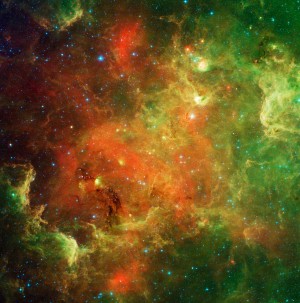Posts Tagged ‘EarthSky Tonight’
EarthSky Tonight—October 9, Last 2010 evening

Courtesy of EarthSky A Clear Voice for Science www.EarthSky.org Tonight presents the final pairing of the moon and the planet Venus in the evening sky until the autumn of 2011. Or, if you live in the southern hemisphere, it is the last evening pairing until the spring of 2011. Unfortunately, for much of the northern hemisphere, a “perfect” storm of events makes the sighting of the waxing crescent moon and dazzling Venus difficult – if not downright impossible – to observe. Bright star ... Full Story
EarthSky Tonight— October 8, Close-up on

Courtesy of EarthSky A Clear Voice for Science www.EarthSky.org Here’s a close-up look at the constellation Auriga the Charioteer. Its brightest star is called Capella. This constellation and its brightest star are easy to identify in the northeast by mid to late evening. If you don’t see them, try looking a bit later at night – especially if you live in the southern U.S. If you’re unsure whether you’ve identified Capella, you can always look nearby for a small triangle of stars. ... Full Story
EarthSky Tonight—Oct. 7, Legendary Draconid meteors

Courtesy of EarthSky A Clear Voice for Science www.EarthSky.org For the next few nights, Draco the Dragon may or may not be spitting out “shooting stars,” also known as meteors. The legendary Draconid meteor shower is predicted to peak on the night of October 7 or 8. This shower produced major displays in 1933 and 1946 – with thousands of meteors per hour seen in those years – but since then has been so spotty that the tried-and-true Observer’s Handbook – source of so much ... Full Story
EarthSky Tonight—Oct. 6, Golden Capella sparkles red
Courtesy of EarthSky A Clear Voice for Science www.EarthSky.org At this time of year, the star in the northeast at around 9 p.m. is Capella in the constellation Auriga. Every year around this time, we get questions from people who see this star twinkling with red and green flashes when it is low in the sky. On October 12, we talk about Arcturus, the brilliant star in the western evening sky. When Arcturus looms low or sets in the west, that is the time to look for Capella in your northeast ... Full Story
EarthSky Tonight—Oct. 5, Glowing pyramid of light in

Courtesy of EarthSky A Clear Voice for Science www.EarthSky.org Autumn is the best time of year to see the false dawn, also known as the zodiacal light. This light can be noticeable and easy to see from latitudes like those in the southern U.S. I’ve seen it many times from the latitude of southern Texas, sometimes while driving a lonely highway far from city lights, in the hour or so before true dawn begins to light the sky. In that case, the zodiacal light can resemble the lights of a city ... Full Story
EarthSky Tonight—Oct. 4, Use Summer Triangle to

Courtesy of EarthSky A Clear Voice for Science www.EarthSky.org At this time of year, you can use the Summer Triangle – and the constellation Cygnus the Swan – to locate the plane of our Milky Way galaxy. The three brilliant stars that make up the Summer Triangle shine way up high in the October evening sky. I suggest viewing the scene from the comfort of a reclining lawn chair, with your feet pointing southward. As seen from mid-northern latitudes, the stars Deneb and Vega hang high ... Full Story
EarthSky Tonight—Oct 3, Find the Andromeda galaxy

Courtesy of EarthSky A Clear Voice for Science www.EarthSky.org Find the Andromeda galaxy on these dark autumn nights. The large square pattern on today’s chart is the Great Square in the constellation Pegasus. The constellation Andromeda can be seen as two streams of stars extending from one side of the Square, beginning at the star Alpheratz. I learned to find the Andromeda galaxy by star-hopping from the Great Square to the two stars marked here – first Mirach, then Mu Andromedae. An ... Full Story
EarthSky Tonight—Oct 2, Jupiter is a guide to Great

Courtesy of EarthSky A Clear Voice for Science www.EarthSky.org A fixture of the autumn night sky, the Great Square of Pegasus appears to the upper left of the blazing planet Jupiter at early evening. For some idea of the Great Square’s size, extend your hand an arm length from your eye. These stars are far enough apart so that the width of your hand should slip in between any two Great Square stars. By the way, if you are a baseball fan, you might imagine these four stars as a celestial ... Full Story
EarthSky Tonight—Sept. 30, What bright star flashes

Courtesy of EarthSky A Clear Voice for Science www.EarthSky.org Every year in late September and early October, we get questions from people who see a bright star twinkling with red and green flashes, low in the northeastern sky. Capella is a golden star when seen higher up in the sky. If you could travel to it in space, you’d find that it’s actually two golden stars, both with roughly the same surface temperature as our local star, the sun . . . but both larger and brighter than the ... Full Story
EarthSky Tonight—September 27, Summer Triangle high

Courtesy of EarthSky A Clear Voice for Science www.EarthSky.org Even as autumn is beginning, we still have several months to watch the large asterism known as the Summer Triangle. This huge star pattern looms from south to overhead in the autumn evening sky. The Summer Triangle consists of three bright stars in three separate constellations. The stars are Vega in the constellation Lyra, Deneb in the constellation Cygnus, and Altair in the constellation Aquila. Today’s chart has you looking ... Full Story








